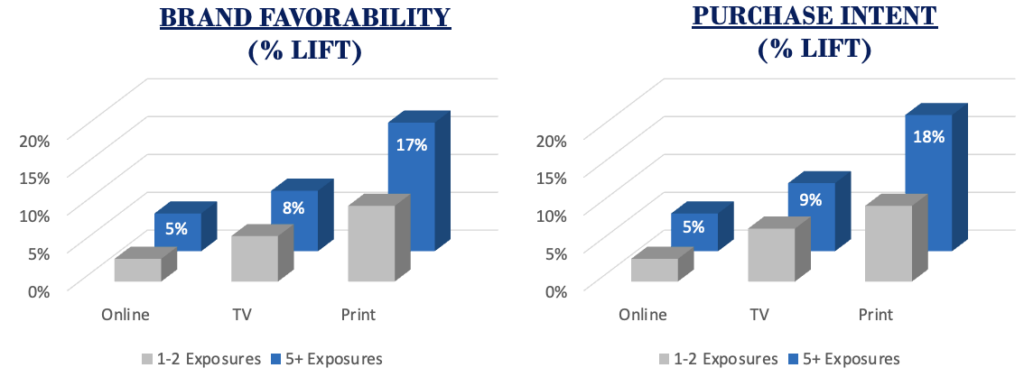The power of print magazines has been a steadfast cornerstone of many brands’ media plans, especially in niche markets like hearing aids. The connection between print magazines and the hearing aid market reveals a compelling narrative of trust, influence, and targeted reach. This article explores how print magazines effectively engage a specific audience and drive significant results for hearing aid advertisers.
The Reach of Print Magazines
Consider Jane, a primary caregiver for her elderly parents. She’s among the 14 million primary caregivers who rely on print magazines for trustworthy information. These magazines reach 88% of all caregivers, making them a vital source of advice and recommendations. Caregivers, like Jane, frequently consult these publications, not just for caregiving tips but also for health-related advertisements to stay atop of the market’s latest offerings. This makes print magazines an invaluable tool for advertisers looking to reach people like Jane who play crucial roles in healthcare decisions.
Print magazines’ reach extends beyond caregivers. Imagine John, a fitness enthusiast in his late 50s who has recently started experiencing hearing loss. John represents the 89% of individuals who purchased hearing aids last year and are avid print magazine readers. For John, magazines are a source of reliable information, far surpassing what he finds on the internet or social media. This preference highlights a significant opportunity for hearing aid advertisers to connect with consumers who trust and engage with print media.
Engaging an Active Audience
Magazine readers are not just passively flipping through pages. They are actively engaged in improving their health and lifestyle. For example, Mary, a hearing aid user, is always on the lookout for new ways to live healthier. She is part of the 77% of magazine readers who prioritize health innovations. Mary exercises regularly, attends live events, and enjoys traveling. This active lifestyle is common among magazine readers, making them an ideal target for health-related advertisements. They rely on the best-in-class products that the editors (the original influencers) are relaying in their pages.
Moreover, magazine readers are often influential individuals, guiding the health decisions of their friends and family. With over 50 million “healthcare influencers” reading magazines, magazines reach 88% of these key opinion leaders. When Mary recommends a hearing aid she read about in her favorite magazine, her endorsement carries significant weight within her social circle. This word-of-mouth influence amplifies the impact of magazine advertisements, reaching a broader audience beyond the direct readers.
Trust and Recall in Advertising
The trust placed in print magazines translates directly to advertising effectiveness. More than half of magazine readers recall pharmaceutical advertisements, and 75% of those take action based on what they see. This high level of engagement is critical for hearing aid brands. When hearing aid companies like MD Hearing Aid, Miracle-Ear, Sound Wise, Nano Hearing Aids, Beltone and Cochlear Limited, among others, ran 231 pages of ads in magazines last year, they were tapping into this powerful trust and recall mechanism.
John, Mary, and Jane represent millions of consumers who not only remember the ads but are also likely to act on them. Magazine readers account for 89% of all spending on prescriptive medical solutions, amounting to $5.1 billion per month. This spending power highlights the substantial return on investment for advertisers who choose print media as a key component of their media mix.
Building Brand Favorability and Purchase Intent
Research consistently shows that frequency in print advertising builds brand favorability and purchase intent more effectively than other media channels. Consumers like John trust print magazines over websites and TV networks for healthcare recommendations. This trust is pivotal for advertisers aiming to build strong, favorable brand perceptions.

To visualize the impact of print frequency on brand favorability and purchase intent, consider the above bar chart that compares the effectiveness of print magazines, websites, and TV networks, over the course of a 8 year study from Milward Brown. The data clearly show that print magazines lead the way, reinforcing the value of a well-placed magazine ad. Bottom line is that more exposures among print readers builds higher brand favorability and purchase intent, surpassing the next leading medium.
Conclusion
The narrative of print magazines and the hearing aid market is one of trust, influence, and targeted reach. Print magazines connect with a health-conscious, proactive audience that values reliable information and recommendations. For advertisers, this medium offers unparalleled advantages in building brand favorability and driving consumer purchase intent. By understanding and leveraging these insights, hearing aid advertisers can effectively reach their target audience and achieve their marketing goals through the enduring power of print magazines.
Sources include Page Four Media research; MRI-Simmons Fall 2023; MRI-Simmons Spring 2023; MRI Starch FY 2023; Media Radar, Top 100 MPA Titles – January 01, 2023 to December 31, 2023; Millward Brown ‘07-’15; Dotdash Meredith Sales Guarantee Studies 2010-2022 as measured by NCS; News Media Alliance, 2022 Magazine Media Factbook; Relevant links found within article.




